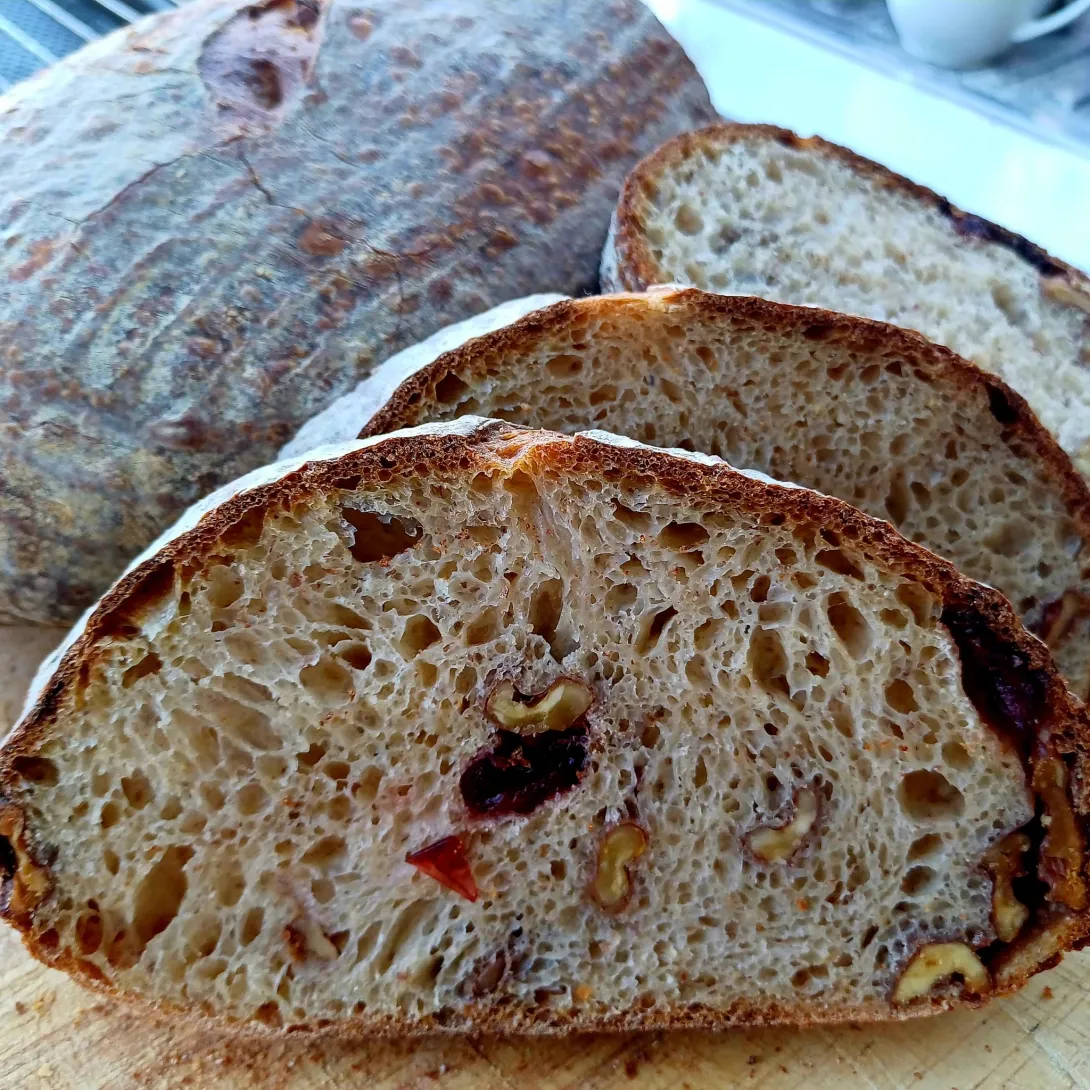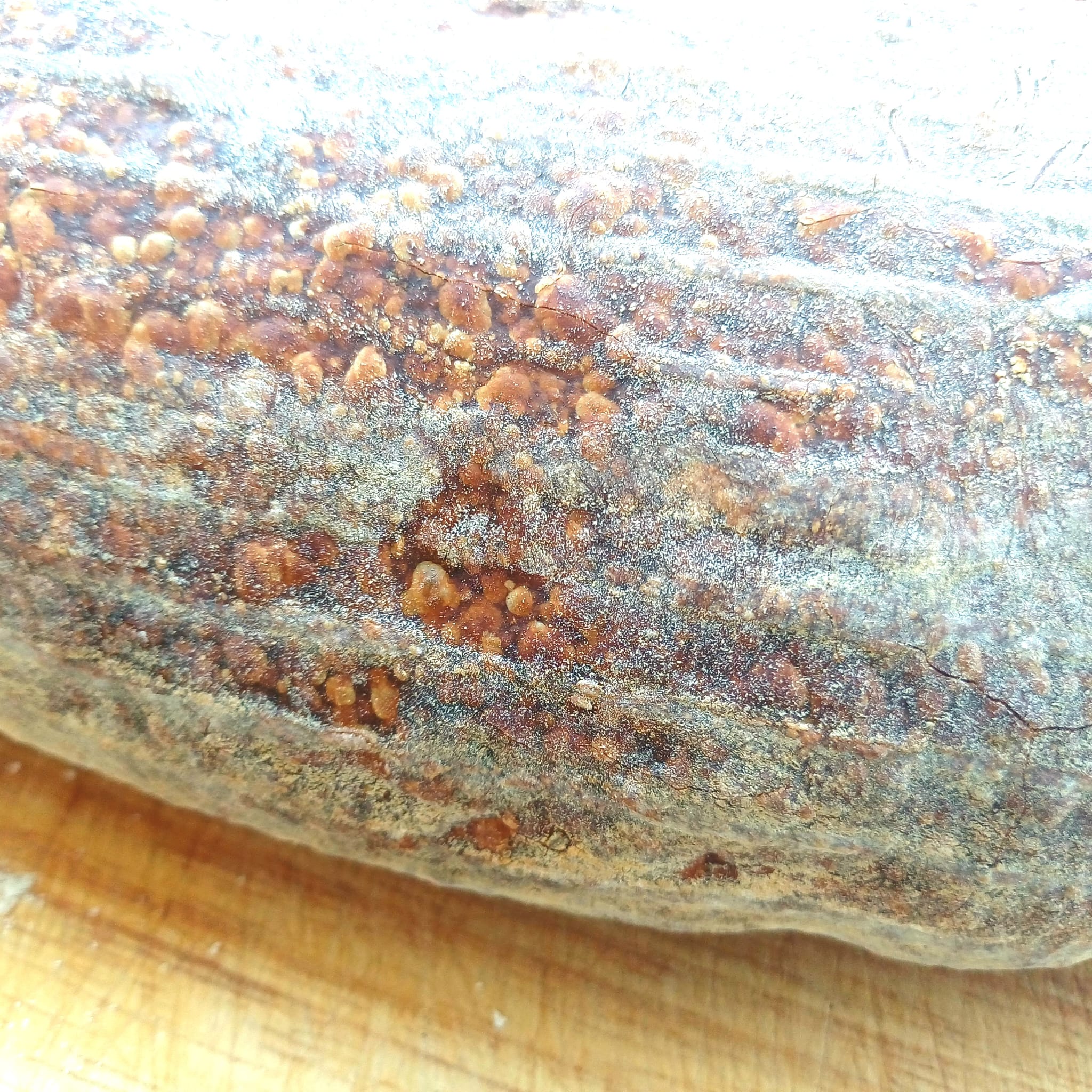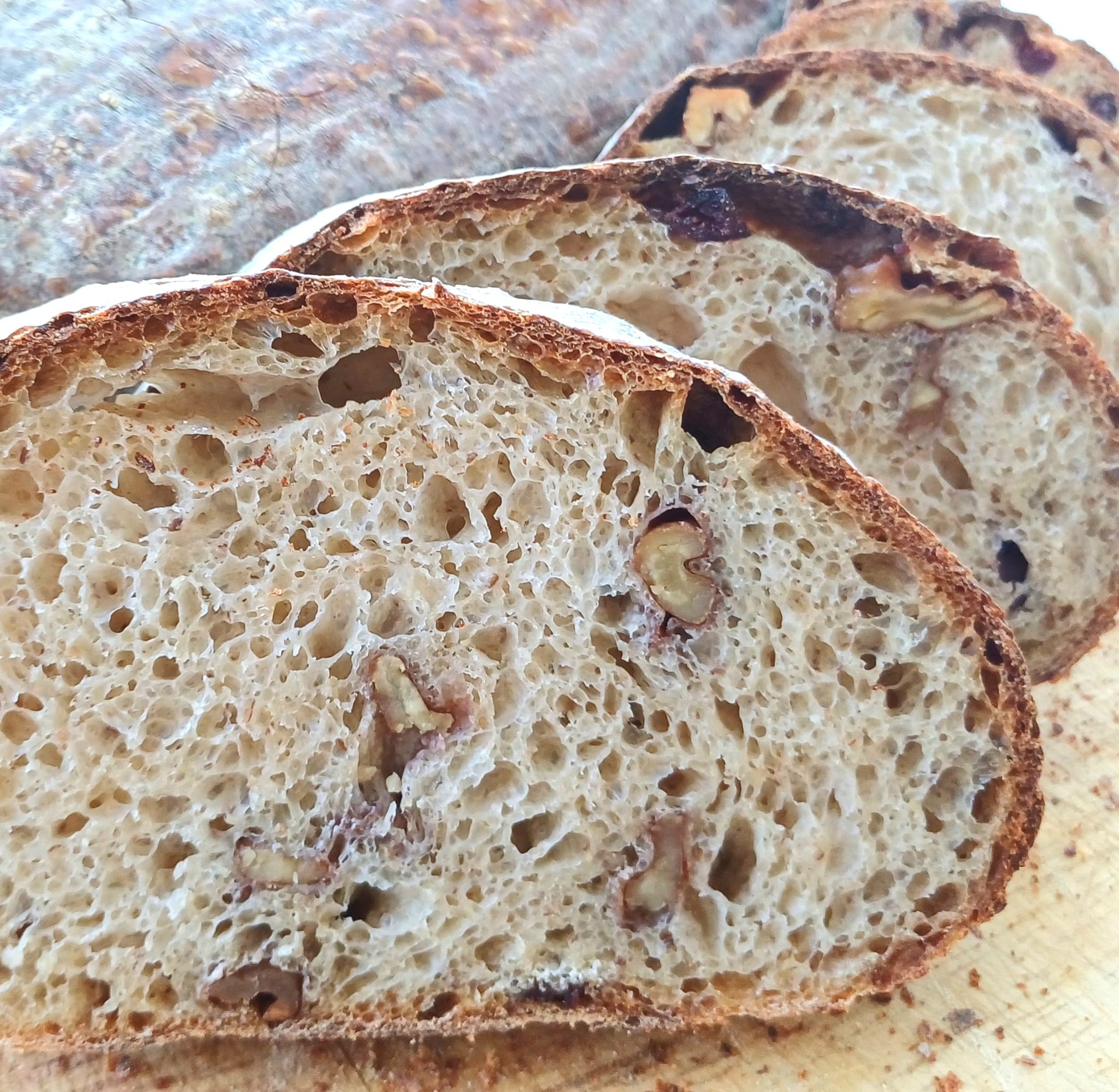
I felt like making my standard loaf yesterday but also felt like messing up processes that I have settled into for some time, just for the fun of it.
The standard loaf is usually made like this: I pre-ferment about 30-50% of the flour (usually whole grains in the PFF) for 12 to 16 hours depending on whether it's a 90% hydration levain or a 45% hydration biga, then mix in bread flour and water the next day, giving BF about 3-5 hours, add walnuts and cranberries then final proof about 1.5-2.5 hours, baking the loaf on the same day for lunch. The bread is flavourful with very subdued sourness, the crumb is soft but elastic, and the crust is crackly, not tough.
Yesterday, I decided to mess things up by swapping the pre-fermentation time and the final proof time. So I made a really quick levain consisting of rye, khorasan and spelt that took 2.5 hours to double (when it would usually take 12-16 hours with a very low inoculation), mixed it with bread flour and allowed the dough to BF till about 50% rise with a couple of SFs (about 4 hours - same as before), then left it in the fridge and baked it 16 hours later (when usually final proof would be just 1.5-2.5 hours). PFF was 30% and hydration was about 75%.
I did not notice many differences during the process, except that the loaf did grow substantially in the fridge, and was a little bigger than I would have allowed final proof to go on the counter if I were to bake it on the same day. I was worried that it wouldn't rise in the oven, but it did (albeit without producing a ear, but that's fine for me)! I think this is an indication to me that I can stretch my SOP proofing times a little more.
For the same start/end times and duration of dough handling, this loaf turned out quite different from my usual loaf:
Crumb - more open, more shreddable, generally lighter
Crust - darker and more golden, many more blisters (see below)
Flavour - better flavour, but way more sour!!!!

Another crumb shot:

I'm looking forward to messing up more loaves.
- ll433's Blog
- Log in or register to post comments
I love the surface texture shot. That looks delicious.
That was indeed delicious - all gone now.
better taste, softer, more extensible crumb, blistered crust. Sounds fantastic. I'd say flipping the script was a winner.
A few q's:
--was the crust still thin 'n' crispy?
--what's your usual inoculation %age and what was it with this version?
--to what do you think we can attribute the different characteristics (more flavor, more shreddable crumb, incredible blistering) -- in other words, what might we learn from this?
Thanks,
Rob
The crust was extremely crispy, but it was not as thin as I would have liked it. It seemed to me that this loaf could have been taken out of the oven slightly earlier than usual. It took way less time to get golden brown, and the loaf was much lighter and more hollow for the same duration it was in the oven.
My usual levain ratio for 12 hours is around 1:10:10 and this time it was 1:2:2, going by starter:flour:water. I generally use a bit less water to get a slightly drier levain, so something more like 1:10:8 and 1:2:1.7. For my bigas, it would be 1:10:5.
I think the blistering, shreddability and increased sourness can definitely be attributed to the 16-hour cold retard. It's not very long by most bakers' standards, but it's long enough for really noticeable changes compared to a same day bake with the long fermentation shifted to pre-fermentation rather than final proof. I like this crumb more than my usual loaf, because it is shreddable but still springy to the bite, if you get what I mean. There is a great amount of flavour and the increased sourness really does make you pay attention to the bread. But of course, there are days when we prefer to listen to Satie rather than Prokofiev...?
great explanations, Lin.
Honestly, though cold proofing is said to make bread more sour, I've never experienced the immense leap you have. The only super sour breads I've made have been with multiple-stage levains that started with very small inoculations.
That being said, I probably listen to more Berio and Varese and Scelsi (and grittily dissonant rock & jazz) than Satie and Prokofiev -- does that mean I'm a sourpuss?
Rob
Damn, Rob, I had to look up those names 😂
I think it's the combination of the quick levain and the slightly longer cold retard. I've almost never had sour breads from same day bakes (i.e. without any refrigeration), except for the time I proofed my focaccia in a warmer place that got just a little too warm.
Wow! I've known very few people that like the music of Varèse and Berio. I got turned on to 20th century classical composers while studying toward a music minor in college. I have to say I prefer Varèse (Amériques and Arcana are a blast!) over Berio but I'll listen to both. What's your take on other composers from that era like Arnold Schoenberg, Charles Ives, Olivier Messiaen, Lou Harrison, John Cage, et.al.?
I don't think your music preferences mean your a sourpuss; more like a connoisseur of avant-garde music.
Now those are names.... I haven't heard.... in a very long time.
I think it's all good. So long as we stay away from the futurismo and fascist strains. :)
I performed a Scelsi piece on double bass back in the day, and wrote an analysis using the framework of atomic valences... why I never became a famous musician, I'm still not sure.
Whoa! it must have been incredible to perform a Scelsi work! And to understand it through atomic structure. Which one? I want to listen to it.
I only discovered Scelsi recently. I used to play French Horn (decently but never total pro quality) & rue the fact that I never got to play any of his rumbling, world-cracking 60's orchestral ruminations -- Aion is my current wow.
And, yeah, there's an unfortunate bridge between ecstatic futurism and essential fascism. Avoid, avoid! The world, it is turning out, seems to be ok with all that ... but ... we on this site are just baking (and breaking) bread.
Rob
I listen to quite a bit of Berio -- mostly the Sequenzas. Varese I love as well -- more for his percussion things. Cage works for me -- though when I was in college I saw a fantastic concert of his prepared piano pieces and, a few hours later, I snuck back into to hall and the prepared piano was still there & I played a C scale and it sounded like genius. His books are amazing, too.
I love Ives -- though I admit his 'Americana first' stylings are kitch. Schoenberg leaves me cold ... but Berg & Webern I really like.
Got any still-alive composers you'd recommend?
Rob
First of all -- Lin -- that's a really beautiful looking loaf.
Secondly, on this hijack fork thread, I played/analyzed Scelsi's Maknongan. But really, I think he and his strain is just a portal to give classical musicians a chance to improvise in acousmatic space and get into the world of timbre. It's like a trick to get you off the page and into your mind. I never found any recordings that I loved; nothing beats the process of just making your own sound. Like shaping a loaf!
The Sequenzas are super bomb! Some of my favorites! That super rad that you got to play on a Cage prepared piano! Sneaking in is definitely a mode he (probably?) would have appreciated.
I'm not really following contemporary music anymore, listen more to rhythm music, American roots, instrumental folk. Body music. I've had enough of using my brain.
Sofia Gubaidulina recently passed away; so "almost" living. Can you be "almost" living? Her music is amazing.
I wish I liked Jacob Collier's music. I think is some sort of musical genius, but I don't love the textural elements of his music that much.
Hm, what else. Actually, what about Davidovsky? He's written a lot for solo instruments, kind of in the vibe of the Sequenzas.
Oh! What about Brian Ferneyhough?? :) Salvatore Sciarrino? Oh yeah, and Murail / Grisey and other spectralists? I see the spectralists as achieving a sort-of unified-field-theory of western classical music, successfully synthesizing the German structuralism and French timber and colorism. I'm sure that would make a musicologist, somewhere, spit coffee, but....
Clearly, I got some listening to do ... as well as baking.
Thanks for the notes ... and the fantastic description of playing Scelsi. I once made fire by spinning two sticks together with a home-made bow drill & I can imagine producing scelsi sounds is kinda like that.
And, yeah, Lin's baking is phenomenal. Mb we should start an off-topic thread about mod music and get everyone here listening.🤣😎
Rob
But I really had to read up on all these names. Where have I been! Thanks for the recs, I'll get them on my playlist, but perhaps not attempt them all at one go. I'm still very old fashioned with my mazurkas and sonatas and what not ;)
I love the way the blisters seem to rise up though a mist of flour. And the crumb with the cranberries poking through is just divine.
Actually, I made similar loaves over the weekend (not as pretty!), more for convenience sake - with a high inoculation levain and a long cold fridge retard. And I was eating my sandwich at lunch time today and thinking to myself that I'm not such a fan of the sour taste! My loaves are normally same day and with a low inoculation levain as I'm ambivalent about the sour - I love that sourdough breads don't taste like yeasted loaves, but I don't want them to get those extra flavour notes too. I'm not sure where all the sourness comes from, but I am thinking of not wrapping in the fridge.
I do like opening the fridge to discover a well risen loaf. It is almost like magic! But, we've got to love the loaf too!
-Jon
I had those thoughts, and it's exactly ambivalence that captures my feelings towards the newly acquired sour notes in the bread. I just kept eating this bread without anything on it - it really was a meal in itself. Lots happening. But it's not as usable and multifunctional a bread - a little dip in the broccoli soup and I don't really know what I'm eating there. The sourness really makes me do a double take; it's not a background bread in any sense. And background breads need not be bad or flavourless; like you my same-day long-levain breads have belonged to that category for a long time.
So yes, this type of loaf is definitely for a certain mood. But at least I know what to do to get this profile - many friends around me seek this type of sourness and seem always surprised when I present a sourdough bread that doesn't taste very sour at all!
Certain mood - and I'm sure getting crumb like that without the sour could be a win too.
I'm wondering how to tweak to get a mild bread with crumb like this! For future messing around and experimentation, of course.
Probably the simplest approach is a long room temp bulk and proof or a short fridge retardation rather than an overnight one. Obviously working with a 'young' levain is important. If there were enough hours in the day, and it could all be made conveniently.
And, to expand on my half explained thought above - I'm beginning to think that at least some of the sourness that develops during a fridge retardation might be related to that whiff of volatile compounds (especially those we notice after unwrapping after the fridge). Was wondering if not wrapping it would help as some of it seems to come from the moisture that's accumulated on the surface of the dough.
I like how you play with high 'innoculations' of your doughs - the 30% PFF etc. I went through a phase where I thought doing it fast and vigorously was best, not sure if I know better, but now I'm back closer to the standard 20% and the dough has felt stronger. If the breads are better it is hard to tell, as memory is such a fickle thing.
-Jon
The maths section:
Edit: because the maths of this is tricky - when you say 30% PFF, and your levain is 90% hydration, that means for say 1000g of flour in the final dough, 300g of flour will be pre-fermented, right, which means you'd add 570g of levain! (570g of levain = 300g of flour, and 90% of that in water so plus 270g = 570g)?
Hmmm... and my 20% is not PFF - 200g of levain at 100% hydration, or only 10% PFF
That's exactly it! 30% PFF does result in about slightly more than half the flour weight being made up of the levain!
I've always really enjoyed having a high PFF in my bread. And you know what i'm thinking about when you talk about a milder but flavourful bread with this type of open but still elastic crumb - that would be a 40 or 50% biga bread, say 14 hour pre-fermentation of the 45% hydration biga, then mix and BF in about 4-5 hours, then a moderate cold retard of about 8-10 hours. At the end of the day, it's really about whatever works for the schedule on hand isn't it... ;)
But I'm looking forward to messing up a few more breads these coming weeks and having lots of fun with that.
If you want to use a biga but want more naturally-leavened flavor (without the sour), I have gotten good results using straight yeast + liquid strained from yogurt. I used 1/4 tsp dry yeast and 1 tbsp yogurt liquid for a long overnight bulk ferment. I didn't notice any sourness. I don't see why that approach wouldn't work well with a biga too.
The yogurt needs to be live-culture, of course, and unstrained yogurt may work just as well although I haven't tried that.
TomP
Hint - the sour comes mostly from the starter. You'll always get sour - that's a gimme. But you can - for better words - change it. Another hint - don't let the starter go to far. Play with it - the starter that is - go from there. Enjoy!
Agreed - love playing with the starter - thanks for stopping by!
Nice experiment and lovely crumb.
Best,
Ian
Appreciate it. This was a fun loaf!
Fantastic Lin, wouldn't we all wish to be able to switch it up and come up with such a great loaf.
Benny
If ya don't try - it won't happen. Nuff said. Enjoy!